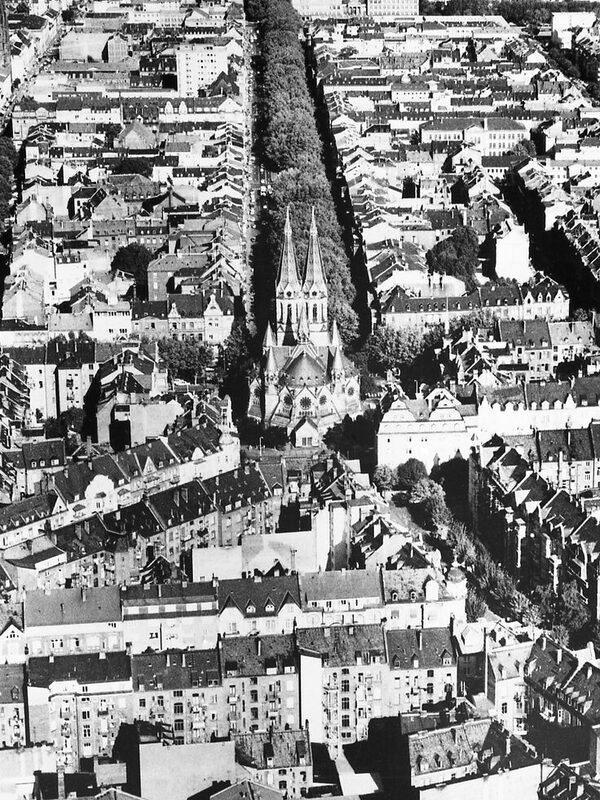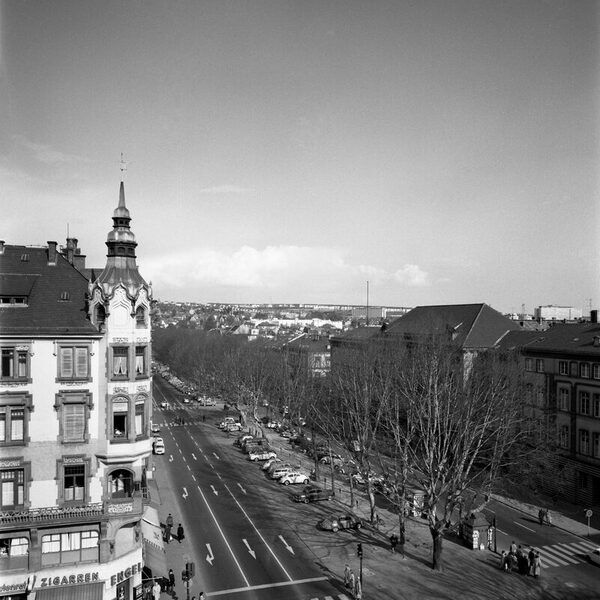Rhine road
Rheinstraße was opened on 17.06.1828. It was initially called Adolphstraße, but was renamed Rheinstraße at the request of Duke Wilhelm zu Nassau. Parallel to Luisenstraße and, like the latter, initially only running from the extended Wilhelmstraße to the extended Schwalbacher Straße, Rheinstraße extended the historic pentagon to the south. Kirchgasse and Marktstraße were also extended to Rheinstraße and in 1830 Luisenplatz was created, opening onto it. Originally, Rheinstraße was laid out asymmetrically with a main and a side road separated by a bridle path and an avenue of plane trees. In addition, a wide sidewalk invited people to take a stroll. It only reached its final extension from Frankfurter Strasse in the east, to which it was not connected until 1910, to Kaiser-Friedrich-Ring with the Ringkirche church in the west in the course of the 1890s.
After Wilhelmstrasse, Rheinstrasse was considered the most prestigious street in the city and, like Wilhelmstrasse, it was initially only built on the city side, the north side. Special regulations applied, as a prestigious street was desired. The planned development of the south side began in 1860. Only a few buildings from the early days of Rheinstraße, which began to be built on in 1828/29 with the artillery barracks between Schwalbacher Straße and Kirchgasse, remain today. These include the corner building at Luisenplatz 1/Rheinstraße 41, which was built in 1835 for the instrument maker August Wolf, and the building of the former orthopaedic sanatorium Dr. J. Carl Crevé from 1833. In 1856, Duke Adolph also approved building areas south of Rheinstraße, which now became the link between the historic pentagon and the adjoining urban extensions.
Today, Rheinstraße mainly consists of residential buildings constructed at the end of the 19th and beginning of the 20th century. There are some architecturally outstanding individual buildings such as the former secondary school built in 1876-79, now the Werner-von-Siemens-Schule, and the building of the Herzoglich Nassauische Landes-Credit-Casse, now the Nassauische Sparkasse. In 1904/05, the former main post office was built, which today houses the Hessian Ministry of Science and Art. In 1913, the State Library was built on the former site of the artillery barracks. The railroad stations on Rheinstraße no longer exist. On the site of the Taunusbahnhof (1840) and Rheinbahnhof (1868) stood the Rhein-Main-Hallen, which were demolished in 2015, and the Ludwigsbahnhof (1879) has made way for the Wiesbaden Museum.
Literature
Niebergall, Rainer: Von Kirchen, Koren und Kasernen - Die Rheinstraße (Straßen erzählen Geschichten), Wiesbaden 2012.
Sigrid Russ, editor, Denkmaltopographie Bundesrepublik Deutschland. Cultural monuments in Hesse. Wiesbaden I.1 - Historical pentagon. Ed.: State Office for Monument Preservation Hesse, Stuttgart 2005 [pp. 363-367; 503-514].
Sigrid Russ, editor, Denkmaltopographie Bundesrepublik Deutschland. Cultural monuments in Hesse. Wiesbaden I.2 - City extensions within the ring road. Ed.: State Office for Monument Preservation Hesse, Stuttgart 2005.

